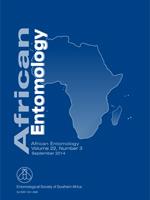Liriomyza huidobrensis Blanchard (Diptera: Agromyzidae) is a highly polyphagous invasive pest in East Africa. Both adults and larvae cause considerable damage to horticultural crops and the pest is considered of quarantine importance for export to the European market. In an attempt to understand the behaviour of this pest for formulation of suitable management and mass-rearing strategies, a study was conducted to determine the effect of host plant on preference and performance of L. huidobrensis. Four host plants: Vicia faba L., Phaseolus vulgaris L., Pisum sativum L. (Fabaceae) and Lycopersicon esculentum M. (Solanaceae) were evaluated for their suitability for feeding, oviposition, development and pupal survival of L. huidobrensis under no-choice and choice conditions. The conditions simulated monoculture and intercrop systems, respectively. Lycopersicon esculentum was the most preferred host for feeding and oviposition, with mean feeding punctures of 23.34 ± 3.35 and 11.59 ± 1.36 per cm2 for no-choice and choice conditions, respectively, and mean number of eggs of 0.57 ± 0.11 and 0.08 ± 0.04 per cm2 for the no-choice and choice conditions, respectively. However, L. esculentum was least suitable for development of L. huidobrensis, with the lowest number of pupae and adults (2.50 ± 0.73 and 1.38 ± 0.46, respectively), pupal survival rate of 6.05 ± 1.95 % and fitness as measured by female and male wing length of 1.84 ± 0.04 mm and 1.57 ± 0.03 mm, respectively. This makes it the best candidate trap crop for management of this pest. On the other hand, V. faba was the most suitable host plant for development of the pest (42.88 ± 11.80 pupae and 32.13 ± 8.77 adults), pupal survival (65.01 ± 13.86 %) and fitness (2.18 ± 0.03 mm and 1.77 ± 0.04 mm, making it a suitable host for mass rearing of L. huidobrensis. Previous experience (rearing history) of the pest significantly affected the selection for feeding and oviposition, but did not affect host suitability for development. Liriomyza huidobrensis fed and oviposited significantly more under no-choice condition than choice set-up suggesting the potential of mixed cropping in controlling L. huidobrensis infestations.
How to translate text using browser tools
1 September 2014
Effect of Host Plant on Feeding, Biological and Morphological Parameters of Liriomyza huidobrensis Blanchard (Diptera: Agromyzidae)
C.A. Okoth,
A.L. Deng,
I.M. Tabu,
K.S. Akutse,
K.K.M. Fiaboe
ACCESS THE FULL ARTICLE
It is not available for individual sale.
This article is only available to subscribers.
It is not available for individual sale.
It is not available for individual sale.

African Entomology
Vol. 22 • No. 3
September 2014
Vol. 22 • No. 3
September 2014
habitat management
host acceptability
host suitability




